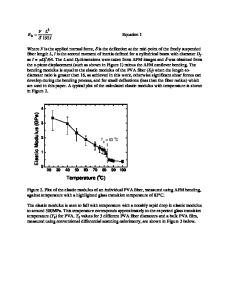Measuring size-dependent mechanical properties of electrospun polystyrene fibers using in-situ AFM-SEM
- PDF / 205,044 Bytes
- 5 Pages / 432 x 648 pts Page_size
- 49 Downloads / 322 Views
Measuring size-dependent mechanical properties of electrospun polystyrene fibers using in-situ AFM-SEM Russell J. Bailey1, Beatriz Cortes-Ballesteros1, Hao Zhang1, Congwei Wang1, Asa H. Barber1 1
Department of Materials, School of Engineering and Materials Science, Queen Mary University of London, Mile End Road, London E1 4NS, UK ABSTRACT The mechanical properties of individual electrospun polystyrene fibers with sub-micron diameters were measured using a combination of atomic force microscopy (AFM) and scanning electron microscopy (SEM). The strain to failure of the electrospun fibers was observed to increase as the fiber diameter decreased. This size dependent mechanical behavior in individual electrospun polystyrene fibers indicates a suppression of localized failure and a shift away from crazing that is dominant in bulk samples.
INTRODUCTION Amorphous polymeric materials are intrinsically tough materials [1]. Polystyrene (PS) is a particular example of an amorphous structure that is expected, in theory, to be tough due to a relatively large strain to failure, but in practice is observed to fail at low tensile strains of a few percent. Previous work has shown that the brittle failure observed in PS consists of crazing events, consisting of a number of microcracks [2]. Critically, the PS within these crazes forms bridging fibrillar structures that can strain towards theoretical limits, known as the natural draw ratio. A mechanism to explain the difference between the natural draw ratio of PS, corresponding to relatively large failure strains, and much lower practical failure strains in bulk polystyrene materials was proposed based on the molecular network density [3]. Specifically, a low molecular network density, as found in PS, can be considered as containing voids between polymers chains that induce localized failure mechanisms. The localization of failure within PS films promotes the appearance of a brittle polymer despite the natural draw ratio being achieved locally. Conversely, a relatively high network density promotes a transition from crazing to shear yielding of the polymer and a delocalization of failure throughout the network [4]. Structural modifications of PS to increase the network density have been achieved previously with high energy electron beams, with a resultant increase in the failure strain of the polymer due to promotion of shear yielding failure [5]. Overcoming crazing in macroscopically brittle polymers is typically achieved by the addition of dispersed rubbery particles within the polymer [6] and suppresses the crazing event when the interparticle distance is smaller than the microcracking failure. The observation of large local failure strains within crazes in bulk polystyrene material and between dispersed rubbery particles has led to a concept of a ‘critical thickness’ where PS behaves as a ductile polymer below this length scale but a brittle polymer when above. Therefore, the production of PS with reduced dimensions is anticipated to increase the ductility of the polymer, and thu
Data Loading...











